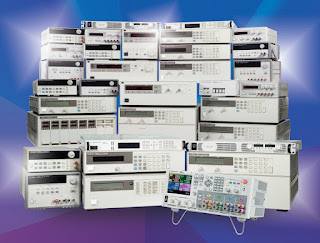Measuring inrush current is a task that many customers that
use DC Power Supplies want to accomplish.
When you are doing this test on the bench, the N6705B DC Power Analyzer
(DCPA) is your best bet. The DCPA has the
scope feature which makes this a breeze.
One of the great things about Agilent power supplies is that they can
measure current directly, without the need for a current probe. Some of our
supplies have very high current measurement accuracy as well so you can get an
accurate representation of your current.
In the below screenshot, I just had a capacitor connected to
the output of the supply. I set a voltage
arbitrary waveform that went from 0 V to 20 V with the voltage slew set for the
maximum. I set the scope to trigger on
the Arb run/stop key so that when I hit the key, both the arbitrary waveform
and the scope triggered. After I
acquired the waveform, I used the markers to get the maximum current. That number is our inrush current.
As I said earlier, DCPA is geared towards bench use. The graphical scope makes this task pretty easy. Many of our system supplies (as well as the DCPA) have a digitizer feature that you can access using the SCPI programming interface. The digitizer will sample the output using settings that you provide it. These settings are: the number of points, the time interval between points, and the number of pretrigger points that you acquire. In the N678xA SMU modules, the time interval is as low as 5.12 us and the number of points is as high as 512kpoints. Here is a list of commands to set up the digitizer (written for the N67xx supplies) as well as some comments.
Set the digitizer to measure current:
SENS:FUNC:CURR
ON,(@1)
Set the number of pretrigger points, a negative value
represents points taken before the trigger:
SENS:SWE:OFFS:POIN -100,(@1)
Set the total number of points to acquire:
SENS:SWE:POIN 5000,(@1)
Set the time interval between points:
SENS:SWE:TINT 0.000020,(@1)
Set the measurement trigger source to bus:
TRIG:ACQ:SOUR BUS,(@1)
Initiate the
measurement trigger system
INIT:ACQ (@1)
Send a trigger:
*TRG
Using this code, once the trigger is sent, the
measurement system will acquire 5000 points at a time interval of 20 us while
taking 100 pretrigger points.
After the measurement occurs, you read the current back
using:
FETC:ARR:CURR? (@1)
Once you have the array of current measurements, you can
do any normal calculation that you can do on any array. To measure inrush, you want to find the
maximum current in the array. This peak
will be your inrush current. I wrote a
program that followed the exact same steps that I used on the scope above (setting
up a step that went from 0 to 20 V and synchronizing triggers) and measured a
maximum of 1.07748 A. As you can see, I got a similar result from the two different approaches.
That is all that I have this month. I hope that it is useful information. If you have any questions at all please feel free to ask them in our comments.







